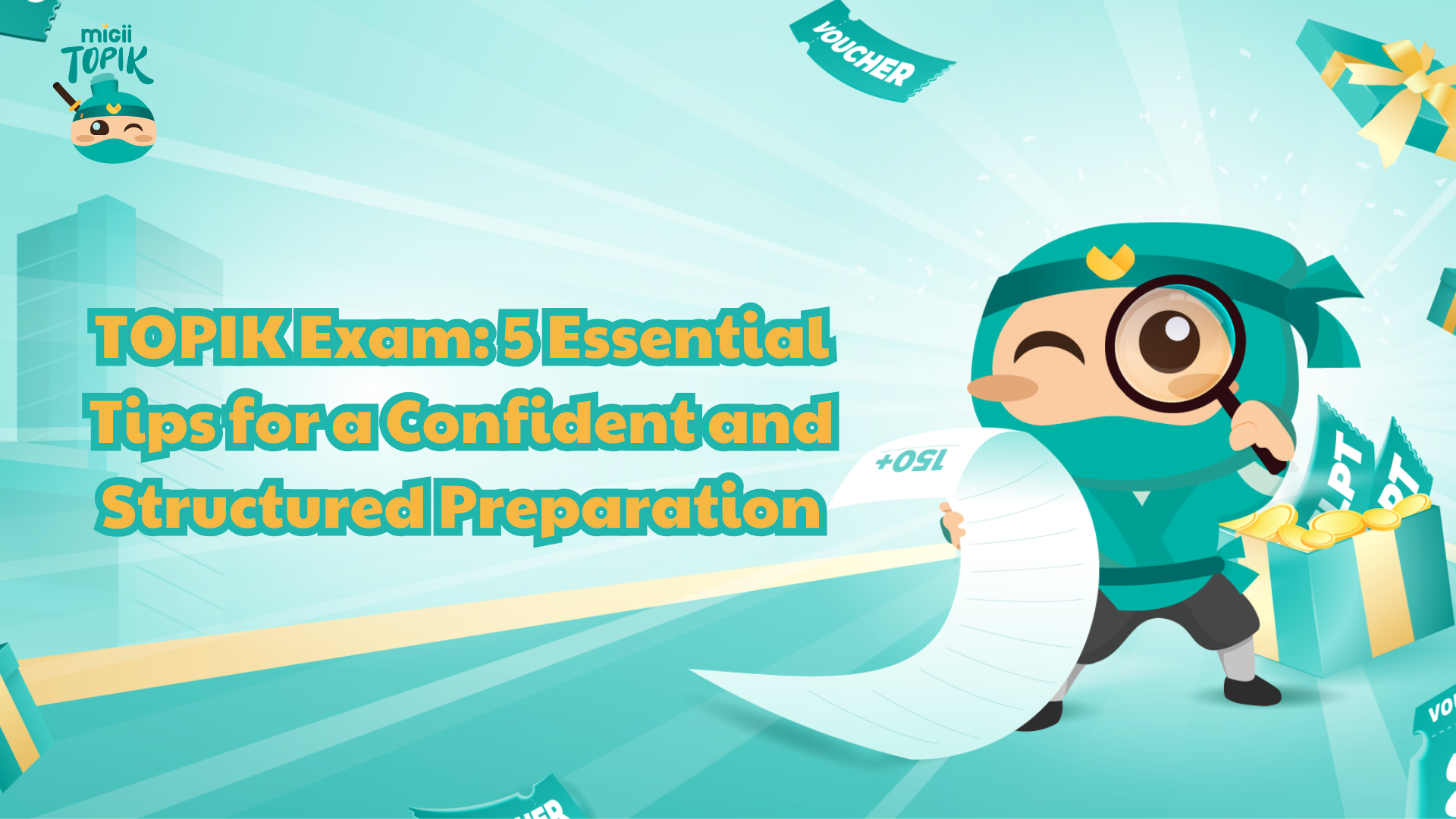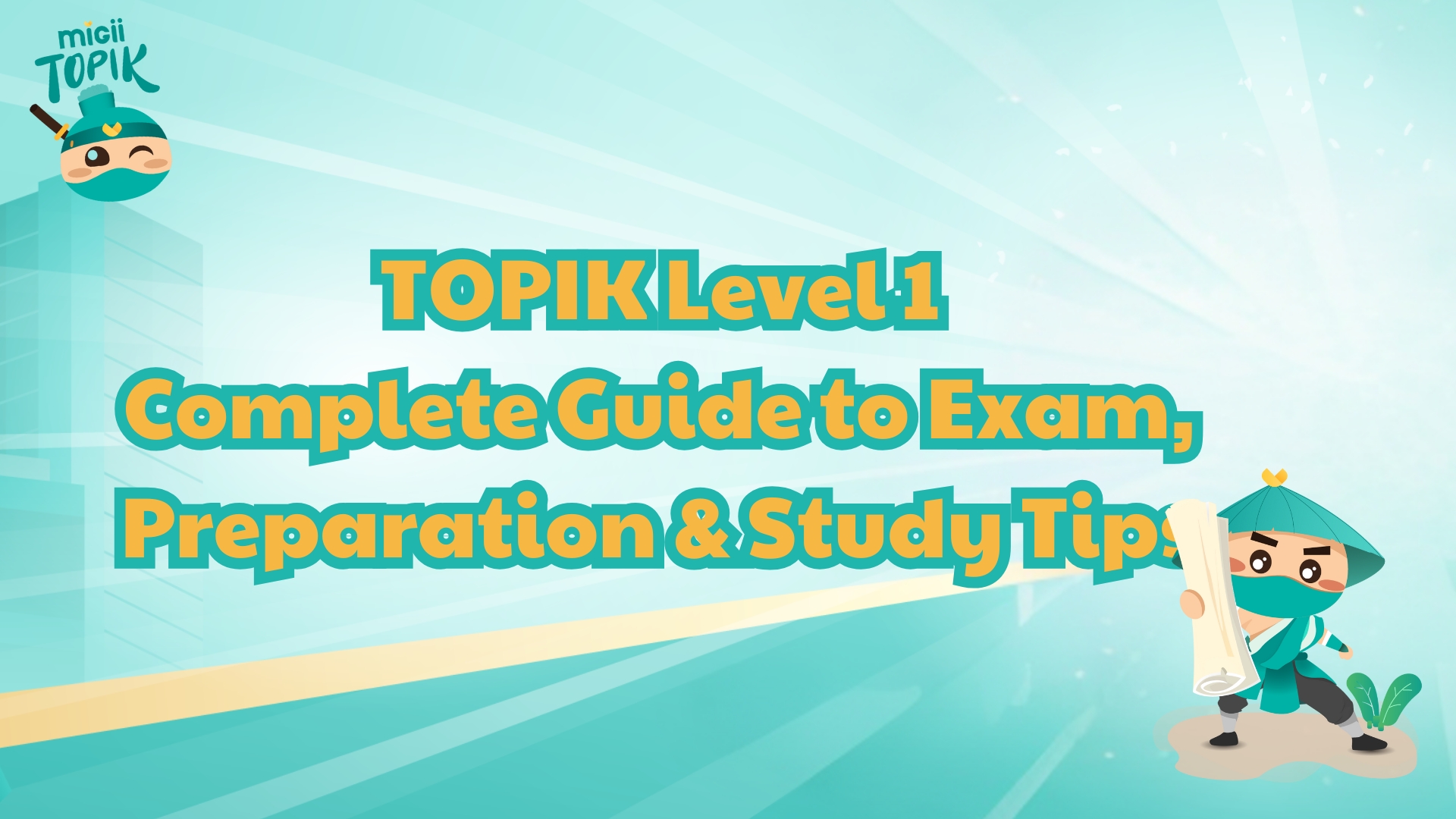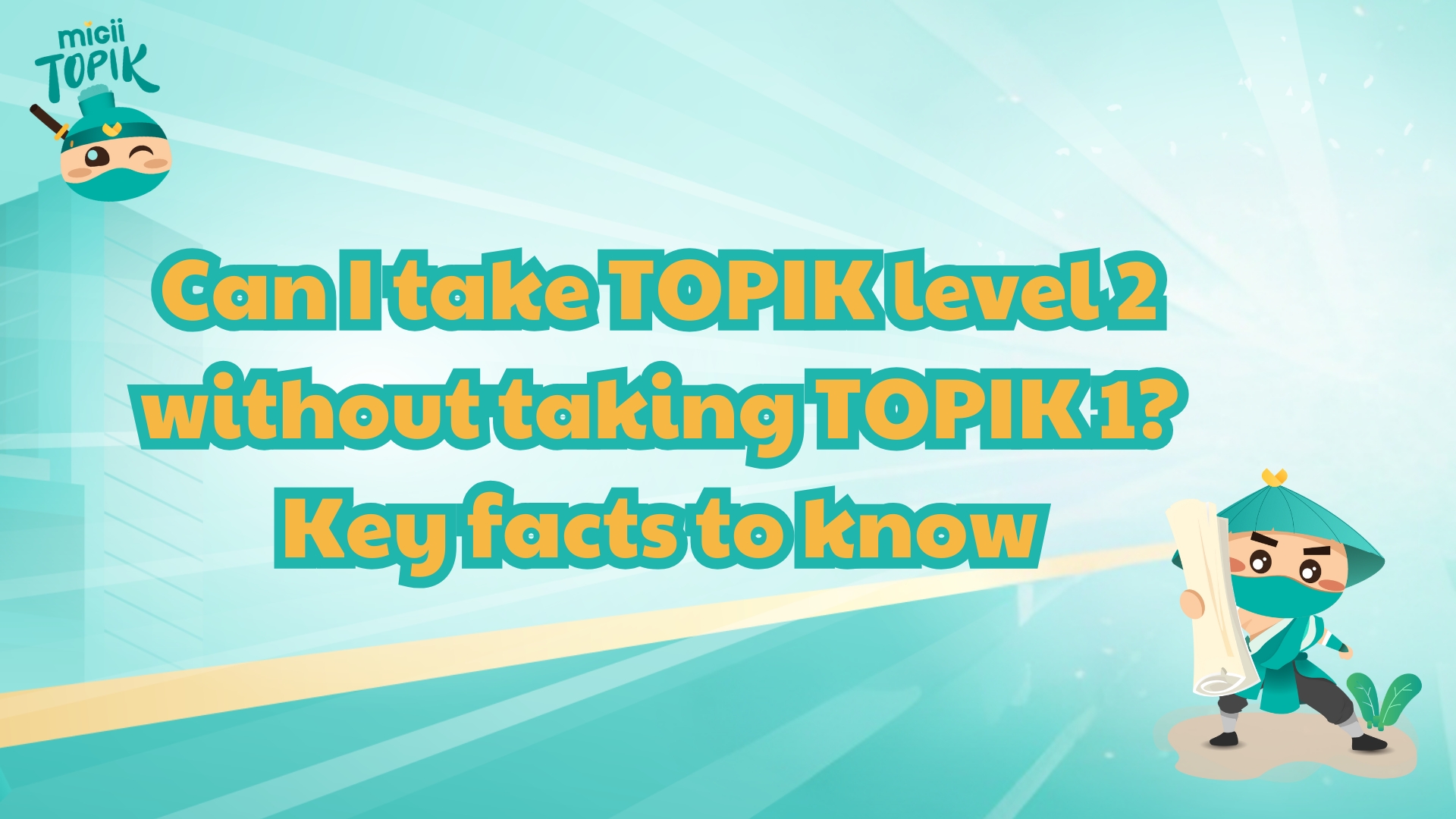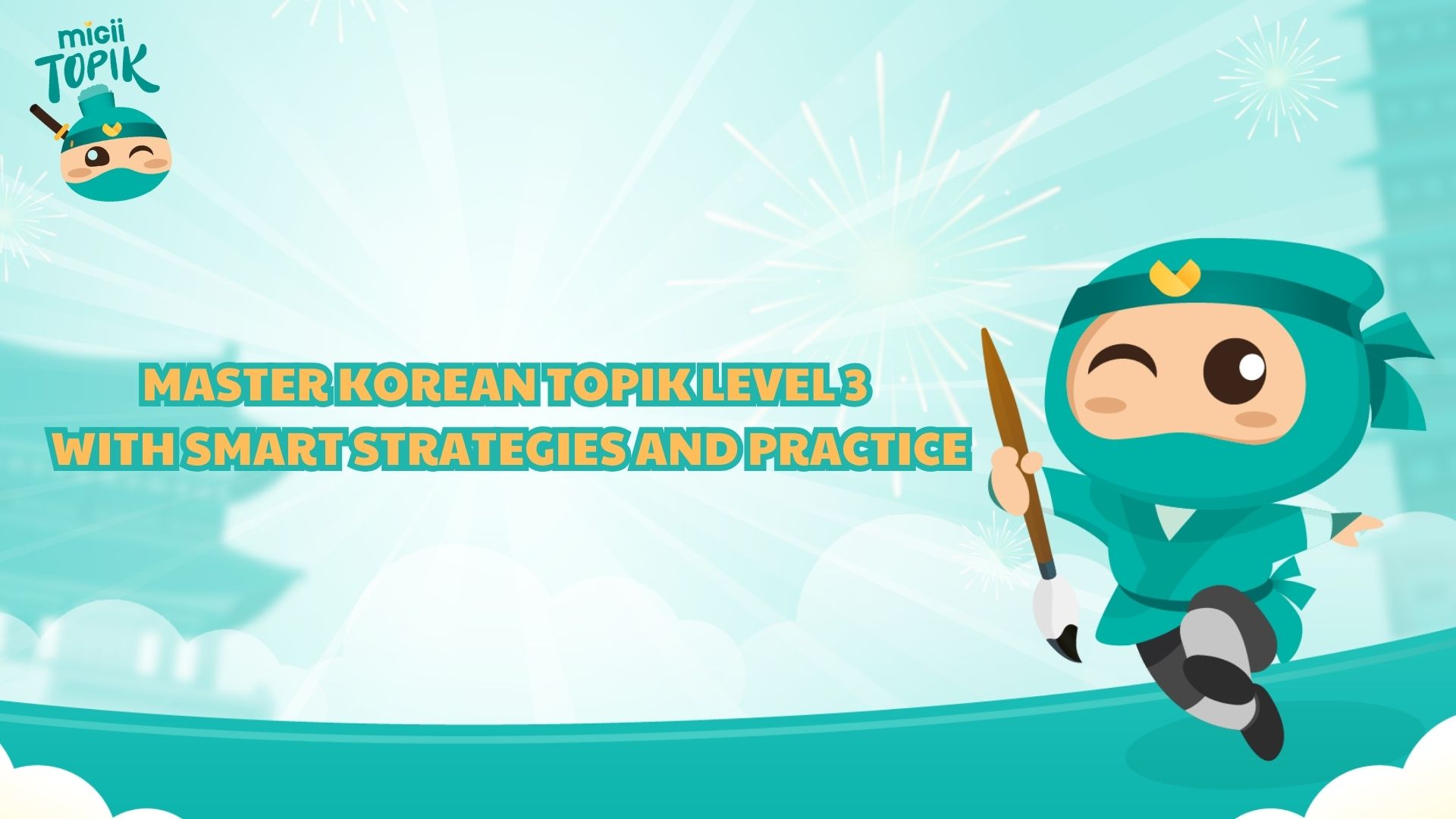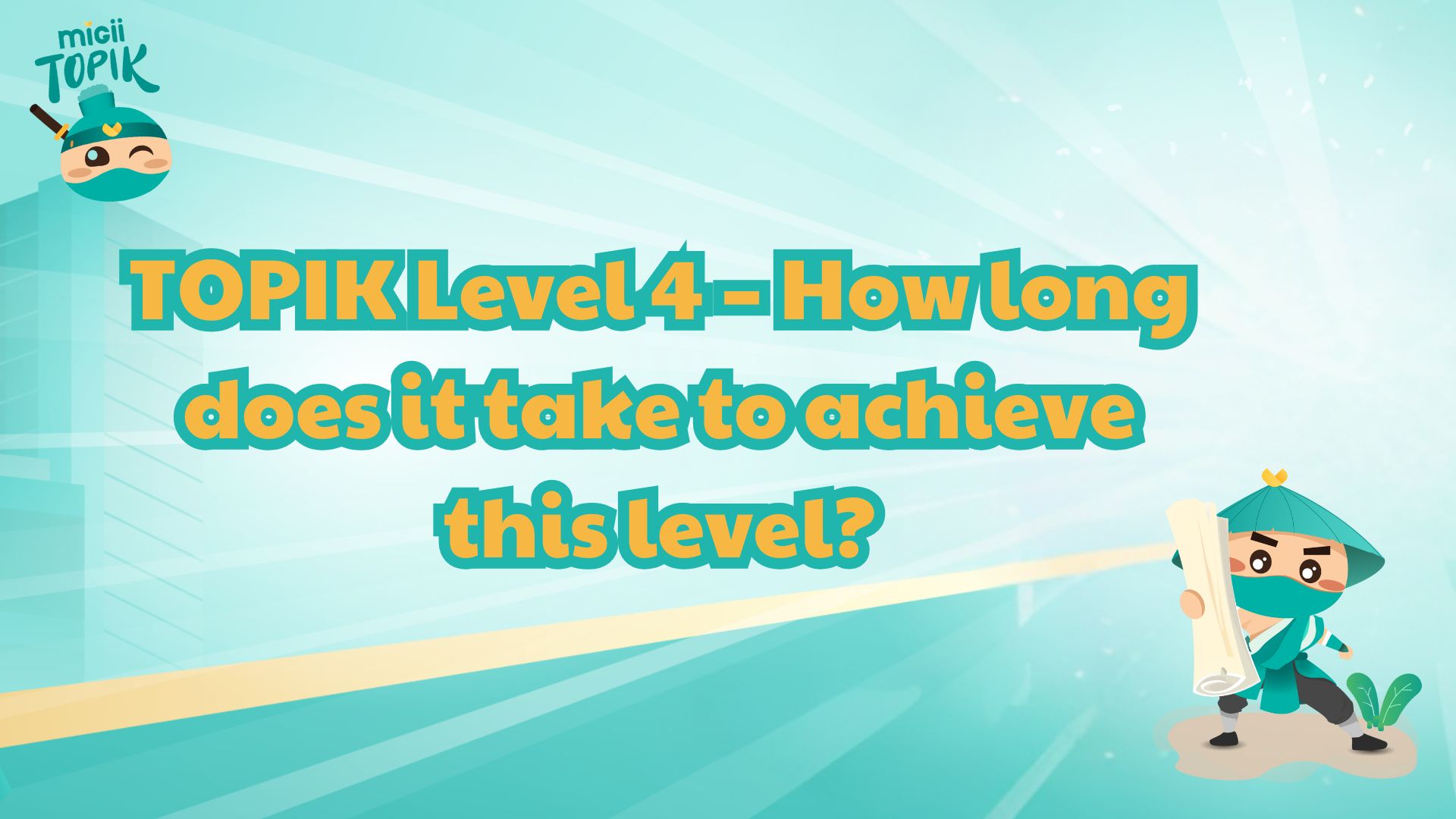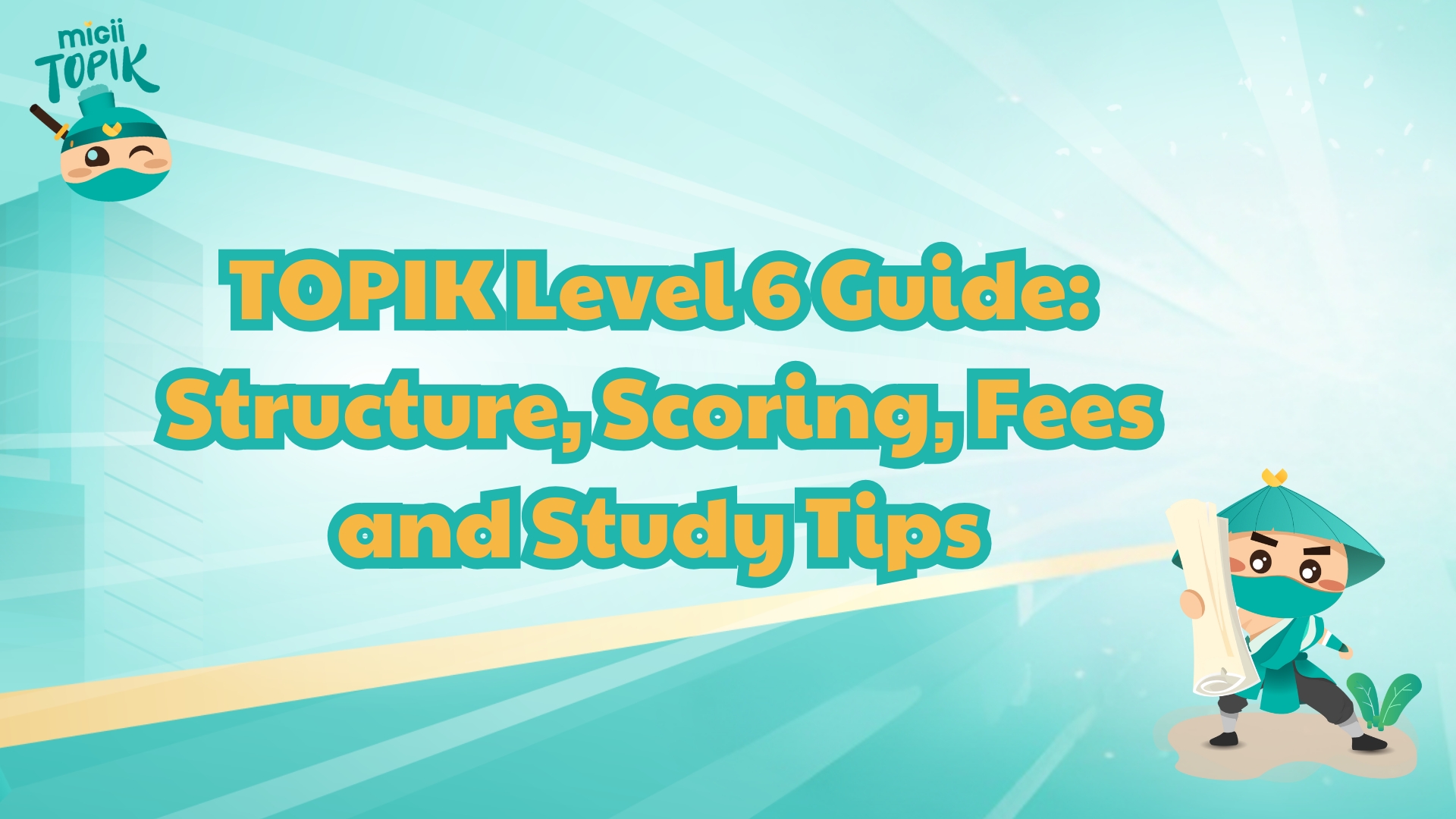Preparing for Korean TOPIK Level 5 is an important goal for anyone aiming to master advanced Korean. At this stage, learners need solid reading, listening, and writing skills to handle academic or professional situations with confidence. Understanding what the TOPIK 5 level exam requires and how to study effectively will make a big difference in your results. Below, Migii will guide you through practical strategies, essential skills, and the best resources to help you achieve Level 5 TOPIK successfully.
What is the TOPIK level 5 exam?
TOPIK Level 5 belongs to the second stage of the Korean language proficiency test system known as TOPIK II, which includes Levels 3 to 6. This level is designed for advanced learners who can understand complex topics and use Korean fluently in academic or professional environments.
A candidate who reaches Level 5 is considered capable of:
- Understanding lectures, news reports, and essays on social, cultural, and technical subjects.
- Writing organized essays that analyze a topic or express opinions logically.
- Using both formal and informal language flexibly according to context.
- Reading academic articles and official documents with comprehension similar to that of a native university student.
This level often serves as a requirement for Korean university admissions, research scholarships, or long-term work visas. In short, passing TOPIK Level 5 proves that the learner can function effectively in Korean-speaking academic and workplace settings.
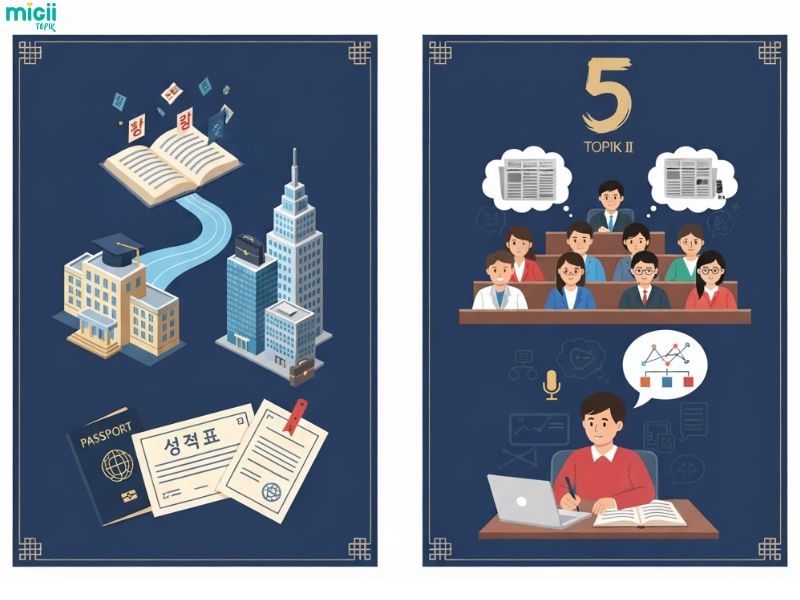
Overview of TOPIK Level 5 structure and its role in advanced Korean proficiency
Structure of the TOPIK Level 5 Exam
The TOPIK II exam (which covers both Level 5 and Level 6) is divided into three main sections: Listening, Reading, and Writing.
There is no separate Speaking section yet, although a pilot “TOPIK Speaking” test is being developed in Korea.
|
Section |
Number of Questions |
Time |
Score Range |
Description |
|
Listening |
50 |
60 minutes |
0 – 100 |
Candidates listen to dialogues, lectures, news, and announcements. The audio uses natural speed and formal vocabulary. |
|
Writing |
4 (2 short + 2 long) |
50 minutes |
0 – 100 |
Includes sentence completion, short paragraph writing, and an essay around 600 words. Tests grammar, logic, and argument clarity. |
|
Reading |
50 |
70 minutes |
0 – 100 |
Involves academic essays, reports, and opinion texts that test vocabulary, comprehension, and inference ability. |
- Total Time: 180 minutes (3 hours)
- Maximum Score: 300 points
The test is held six times per year (usually in April, May, July, October, and November), and results are published around one month after the test date.
A good strategy for test day is to manage time wisely by spending no more than one minute on each question in the listening and reading sections, and setting aside at least five to seven minutes to review your answers before submitting.
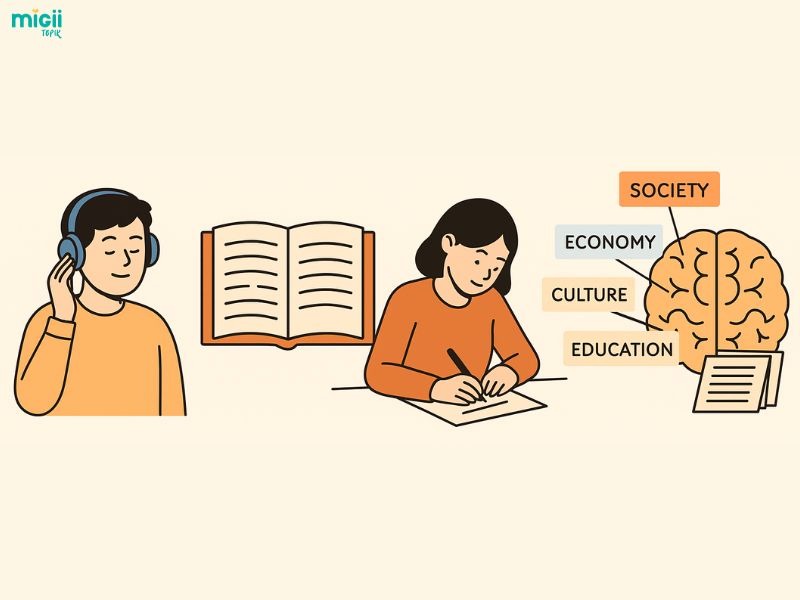
Key skills and scores required to achieve Korean TOPIK Level 5 proficiency
Study plan to achieve TOPIK level 5
Preparing for TOPIK Level 5 requires a focused and consistent approach that balances grammar review, vocabulary expansion, and skill practice. Below are four essential steps to help you study effectively and reach your goal with confidence.
Build a strong grammar base
At this level, grammar questions no longer test basic patterns but advanced logical connectors used in academic writing.
Here’s how to train effectively:
Review grammar from Levels 3 – 4, then focus on formal and connective patterns such as:
- –(으)ㄹ수록 (the more…the more),
- –(으)ㄴ/는 김에 (while doing something),
- –(으)ㄹ지도 모른다 (might / may),
- –(으)ㄹ 뿐만 아니라 (not only…but also),
- –(으)ㄴ/는 척하다 (pretend to do).
Instead of memorizing, create your own sentences using real-life or academic contexts.
Use the grammar section on Migii TOPIK to test each structure through quizzes and writing examples.
Example exercise:
Pick one grammar pattern each day and write three short sentences using it in formal contexts (e.g., university, work, or news tone).
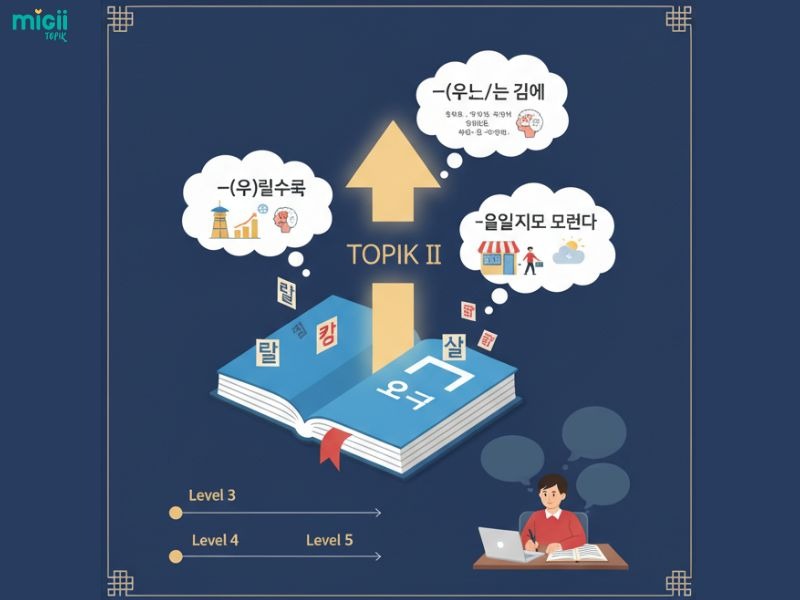
Strong grammar foundation is key to mastering TOPIK Level 5
Expand vocabulary and master korean idioms strategically
To handle the complexity of Level 5 reading and writing tasks, learners should master at least 5,000 – 6,000 words, with a strong focus on academic, social, and cultural topics. In addition to vocabulary, understanding and using Korean idioms (관용어) will help you sound more natural and interpret reading passages more accurately, as idiomatic expressions often appear in essays, news articles, and listening sections.
How to do it effectively:
- Group words by theme: society, economy, politics, culture, and education.
- Learn idioms and proverbs by context: focus on those that frequently appear in real-life communication and formal writing. For example, “발 벗고 나서다” (to take initiative) and “식은 죽 먹기” (as easy as pie).
- Study vocabulary through authentic materials: read Korean news articles (Yonhap, KBS) or Naver blogs to see words and idioms used naturally.
- Use the Migii Vocabulary Book or TOPIK Vocabulary in 30 Days for structured, daily practice.
- Review synonyms and antonyms to refine your sense of nuance, for example “감소하다” (decrease) and “줄어들다” (diminish).
Tip: Create a personal notebook with example sentences and idioms, noting their meaning and usage in Korean only. Avoid direct translation to train yourself to think naturally in Korean.
If you want to explore and practice common Korean idioms used in the TOPIK exam, you can refer to this resource:
https://drive.google.com/file/d/1xsCNwhQM0Uf4jyK9na_0IFTRZY22p-g1/view?usp=sharing
Practice all three sections daily
Consistency is more important than long study sessions.
Plan your week like this:
|
Day |
Focus |
Recommended Practice |
|
Monday |
Listening |
Watch one 15-min Korean news segment, summarize in Korean. |
|
Tuesday |
Reading |
Read one article, highlight new vocabulary, and summarize key points. |
|
Wednesday |
Writing |
Write a short essay (200–250 words) on a social topic. |
|
Thursday |
Grammar + Vocabulary |
Review 5 grammar patterns and 30–40 new words. |
|
Friday |
Mixed practice |
Take one section of a mock test under timed conditions. |
|
Saturday |
Full mock test |
Simulate the real TOPIK II test (180 minutes). |
|
Sunday |
Review |
Analyze mistakes, correct essays, and record improvement. |
Focus on Writing — The Most Challenging Section
The writing section is where many test-takers lose points. You must not only be grammatically correct but also logical and organized. Follow this 3-step method:
- Analyze model essays from official tests to understand structure and transitions.
- Outline your essays before writing by clearly organizing them into an introduction, body, and conclusion.
- Time your writing: aim to complete the short writing tasks in 10 minutes and the long essay in 30 minutes.
Practice common prompts such as:
- “Advantages and disadvantages of studying abroad.”
- “The role of technology in education.”
- “Why cultural understanding is important in global communication.”
After writing, compare your essay with model answers and correct errors in grammar, logic, or vocabulary.
Migii provides auto-scoring and writing feedback tools that help you identify weak points instantly.
Take weekly mock tests
Mock tests are the best way to evaluate your progress and simulate real exam pressure. They help identify weak points and improve test-taking strategies.
- Take a full-length TOPIK II practice test once a week under timed conditions.
- After each test, review your answers carefully to understand the reasoning behind correct and incorrect choices.
- Make a list of repeated grammar or vocabulary mistakes and review them before your next test.
- Track your score progression to adjust your study plan and focus on the skills that need improvement.
Recommended resources and sample tests
Using the right study materials is essential for achieving TOPIK Level 5, as they help you understand the test format, question types, and time management. Below are some of the most reliable and effective resources you can use to prepare.
Official past papers
Practicing with real exam papers is one of the best ways to familiarize yourself with the structure and difficulty level of TOPIK II.
- Access official past papers from trusted sources like TOPIK Guide, EPS TOPIK, or Migii.net.
- These materials provide authentic question formats and answer keys, helping you analyze your performance and improve weak areas.
- Review older tests to recognize recurring grammar patterns, vocabulary, and writing prompts.
Download TOPIK II Practice Tests (Listening & Writing Sections):
TOPIK II – 52nd Test (PDF):
https://drive.google.com/file/d/1ytH_YWdCkZLGalGIMwuuqAt4KUq2HWiO/view
TOPIK II – 60th Test (PDF):
https://drive.google.com/file/d/1ab7fyYdoO7fzZHjvJQuuEllyJBsK8Vmb/view
TOPIK II – 63rd Test (PDF):
https://drive.google.com/file/d/1zHX8p-gdLdnXtJHQoNeWw6P706fI_nuT/view
TOPIK II – 64th Test (PDF):
https://drive.google.com/file/d/1s09IMNPrNAAyeLyvD1hTCDrikejcF0rt/view
TOPIK II – 66th Test (PDF):
https://drive.google.com/file/d/11MiUMGXrZtHw2ynQp2BgsWbFwQJlqTmn/view
TOPIK II – 83rd Test (PDF):
https://drive.google.com/file/d/1yiSmqLVjtE_0IjJaALO7eVV8Ibjp7w1s/view
Best books for TOPIK level 5 preparation
Well-structured books allow you to study systematically and focus on specific skills required for Level 5.
- TOPIK master II: Offers comprehensive practice for reading, listening, and writing with detailed explanations and model answers.
- TOPIK writing in 30 days: Ideal for strengthening your essay-writing ability through daily exercises and practical writing templates.
- Hot TOPIK II actual test: Provides full-length mock exams that closely simulate real testing conditions, helping learners assess their performance, manage time effectively, and build confidence before the actual TOPIK II exam.
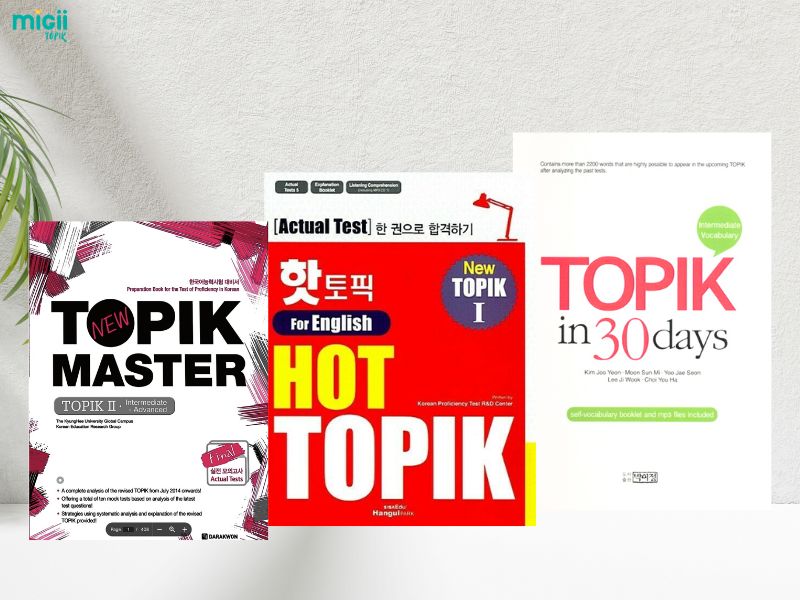
Top recommended books to prepare effectively for TOPIK Level 5
Online Tools and Practice Platforms
Digital tools make studying more interactive and efficient, especially when you can track your progress.
- Take full mock tests on Migii TOPIK, which features auto-grading and score tracking to monitor your improvement over time.
- Use vocabulary flashcards and grammar review sections daily to reinforce what you’ve learned.
- Combine online practice with textbook study to balance speed, accuracy, and comprehension skills.
TOPIK level 5 vs level 6 – Which should you aim for?
Deciding whether to aim for TOPIK Level 5 or Level 6 depends largely on your personal goals and how you plan to use Korean in the future. For most learners, TOPIK Level 5 is already a significant achievement that demonstrates advanced fluency suitable for studying, working, or living in Korea. It allows you to handle professional communication, understand academic materials, and write formal essays with confidence.
On the other hand, TOPIK Level 6 is designed for those who need near-native proficiency such as translators, teachers, or graduate students engaged in research. This level requires not only the ability to understand complex academic or abstract topics but also to express opinions with nuance, precision, and cultural awareness.
In practical terms, it’s often recommended to secure Level 5 first, then continue developing your skills toward Level 6. Once you reach Level 5, you’ll already have a strong foundation in grammar, vocabulary, and comprehension, making the jump to Level 6 more achievable. Ultimately, whether you choose TOPIK Level 5 or 6, both represent advanced mastery and open valuable opportunities for education and career development in Korea.

Comparison between TOPIK Level 5 and Level 6 goals, proficiency, and practical applications
Tips to reach level 5 faster
Achieving TOPIK Level 5 faster requires a smart learning strategy that combines consistency, active practice, and targeted review. Instead of studying harder, focus on studying smarter with the following tips:
- Set a realistic study plan: Dedicate at least 2 – 3 hours daily for 6 – 9 months, balancing grammar, vocabulary, and skill practice.
- Immerse yourself in Korean daily: Listen to Korean podcasts, watch the news, or follow YouTube channels that use natural, formal Korean.
- Prioritize writing practice: Since the writing section is the hardest, practice writing essays every week and compare your work with model answers.
- Review your mistakes: After each mock test, analyze which grammar points or vocabulary caused confusion, and create a personal correction notebook.
- Expand exposure to formal contexts: Read newspapers, government notices, or university blogs to get used to the tone and structure of advanced Korean.
- Use digital tools like Migii TOPIK: Track your scores, access auto-graded mock tests, and monitor progress over time.
Final thoughts
Reaching TOPIK Level 5 proves that you have a strong command of Korean for study, work, and daily communication. With consistent practice and the right learning strategy, this goal is completely achievable. To make your preparation easier, start learning with Migii TOPIK, an all-in-one platform that provides mock tests, grammar reviews, and vocabulary tools to help you study smarter and reach your goal faster.

